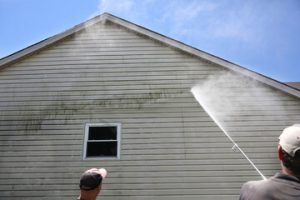Dirt and mildew buildup on vinyl siding can cause it to look dull, but regular cleaning can remove this buildup. Aim to clean your vinyl siding once or twice per year, depending on where you live and how much dirt, dust and grime build up on your home.

You can use a garden hose and soft-bristled brush or a commercial cleaner designed for vinyl siding. Avoid using metal brushes, which can scratch the surface and strip the color. Also, never use a pressure washer to clean vinyl siding, as high-pressure water can crack or damage the surface. Keep reading the article below to learn more about Vinyl Siding Cleaner.
Generally, soapy water and a soft-bristled brush should be enough to remove most dirt from vinyl siding. But for stubborn stains, a mixture of three parts distilled white vinegar and seven parts water should do the trick. This solution is safe for the environment, won’t harm surrounding vegetation and will effectively clean mildew and mold stains from vinyl. You can find this solution online or at most hardware stores.
If you notice mildew stains, scrub the affected areas with this solution in a circular motion. Then rinse the siding with a garden hose with a sprayer attachment. Always remember to wear gloves, safety goggles and a respirator as recommended for the specific cleaning products you choose.
Once your vinyl siding is clean, you can paint it with a low-VOC, semi-gloss exterior house paint that matches its original color. Be sure to paint in a well-ventilated area and on a day when outdoor temperatures are moderate and humidity is low. Also, do not paint over mildew stains, as these can trap moisture behind the paint and lead to rot and mildew in the future.
To maintain your vinyl siding, be sure to keep landscaping trimmed so plants and trees don’t brush up against the house. This prevents scratches, stains and helps air circulate around the house. You should also regularly inspect your vinyl siding for any cracks or loose panels, and promptly address any problems, so they don’t worsen. Doing these simple things can help ensure that your vinyl siding will last a long time and look beautiful in the process.
Prevents Dirt and Mildew
Vinyl siding is a classic exterior covering that’s visually appealing and durable, but it does require regular cleaning to remove dirt, mildew, and other debris. Dirt buildup dulls the surface, and it’s also a breeding ground for mold and other microbes that can damage your vinyl siding and cause stains. Regular cleanings help prevent these problems, and they’re a great way to boost your home’s curb appeal.
Using a garden hose with a sprayer attachment is a quick, effective way to clean most of the dirt on your vinyl siding. For tougher stains, mix a solution of water and a gentle cleaner or mild soap in a bucket and apply with a soft-bristled brush. Make sure to wear rubber gloves to protect your hands, and scrub the surface with a circular motion to work the soap into the dirt. Rinse the solution off with a garden hose to avoid streaks, and repeat as needed until your siding is clean.
To help prevent mildew from forming on your vinyl siding, keep the area surrounding your house free of shrubs, plants, and other items that may rub against the surface. Trim bushes and trees regularly to prevent overgrowth that can rub against your vinyl siding, and consider using a soft-bristled brush with a wide brush head for difficult-to-reach areas. Avoid using harsh chemical cleaners on vinyl siding because they can damage it. A better option is a gentle cleaner that’s safe for vinyl, such as a homemade mixture of white vinegar and water.
Scrubbing your vinyl siding may seem like the fastest and most effective way to clean it, but this method can scratch the surface, which will dull the appearance over time. A more effective and safer approach is to use a soft-bristled brush and mild cleaning solutions, such as distilled white vinegar or oxygen bleach, that are safe for vinyl.
For more severe stains or other serious issues, you may need to hire a professional to perform a thorough deep clean of your vinyl siding. A professional can use specialized cleaning equipment and techniques to remove even the most stubborn dirt, mildew, and other debris without damaging your vinyl siding.
Prevents Mold and Mildew
Vinyl siding is a popular choice for homes in many areas of the country due to its durability and low maintenance. However, dirt, mold, and mildew can build up on vinyl siding over time, affecting its beauty and deteriorating its structure. Regular cleaning of vinyl siding with the proper cleaner can help prevent mildew and mold and keep it looking new.
Mildew and mold can cause a variety of problems for homeowners, including a loss in curb appeal, damage to the structural integrity of the house, and respiratory distress in those who are sensitive. The most effective way to remove mildew and mold from vinyl siding is to clean the surface on a regular basis with a mild cleaning solution. A diluted bleach solution or store-bought vinyl siding cleaner can be used to achieve the best results. Using a soft-bristle brush or sponge is a great way to scrub hard-to-reach spots on the vinyl siding, and making sure to rinse thoroughly with the garden hose or pressure washer afterward can help prevent streaking and leave the vinyl siding in excellent condition.
The frequency with which you should perform your vinyl siding cleaning routine will depend on the environmental conditions in your area and around your home. For instance, if your house is near trees or other vegetation, pollen, sap, and organic debris will build up on the siding more frequently. Your local climate also plays a role, as humidity and moisture can contribute to the growth of mildew. In addition, it is recommended that you regularly trim trees and shrubs to reduce shading of your house and promote airflow, which can also inhibit mildew development.
It is important to wear protective equipment such as rubber gloves, goggles, and a respirator when using more potent cleaning solutions. A mask or respirator is also a good idea when working from heights, such as when climbing ladders to reach second-story vinyl siding. Also, it is a good idea to wear appropriate footwear to avoid slippage and falling. You will also want to remove any outdoor furniture or decorations from the surface of the vinyl siding, and you should cover any plants or flowers near the area with a tarp to protect them from the cleaning solutions.
Prevents Stains
Keeping your vinyl siding clean not only enhances curb appeal, it also protects your investment and prolongs its lifespan. Regular cleaning can prevent deterioration due to mold, mildew, and other unsightly stains. Experts recommend washing your vinyl siding at least once a year and more frequently in humid areas or near trees or shrubs that shed leaves, branches, or other debris.
The best vinyl siding cleaners are biodegradable, non-toxic, and free of harsh chemicals that can damage your home or the surrounding environment. They should be safe to use with garden hose attachments or pressure washers, and they should work well with your specific cleaning tools. Some cleaners can tackle a variety of problems, such as general dirt or oil, while others specialize in mold or mildew removal. Some are even formulated to prevent discoloration and protect against future growth.
Vinegar is a simple DIY cleaner that can remove mildew and other light stains from vinyl siding. It is made by combining 30% white vinegar with 70% water and may be diluted with other ingredients such as laundry detergent or dish soap to make a more robust cleaning solution. Commercially available cleaning products are also formulated to safely clean and protect vinyl siding and often include mold inhibitors to keep your vinyl looking new for longer.
To use a cleaning solution, start by rinsing the siding with a garden hose to loosen any dirt or debris. Next, apply the cleaner to a soft brush or sponge and scrub away the grime in small sections. Begin at the bottom and work your way up to avoid streaking. After scrubbing, rinse the area thoroughly with a garden hose or pressure washer set to a low setting. Be sure to rinse around any flowers, plants, or shrubs to prevent splashing or soaking.


